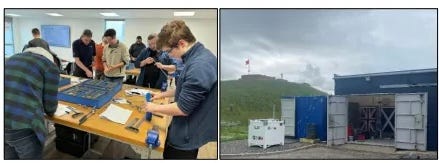Thinking like a Developing Nation
The UK lacks many space capabilities, but that is changing.
Given that the US is the leader in space at the moment, it’s easy to talk about space policy just in the American context - or at best include commentary about their nearest competitors in Europe and China. But this perspective isn’t universally applicable - writing from the UK, our space industry is smaller and comparatively underdeveloped in many ways. Thus, what is good policy in a leading space economy doesn’t necessarily map to what works in a nation such as ours.
In a sense, we need to think like a developing nation, and look at catching up with our more advanced peers.
UK Launch
Our country does not have a very good history with launch vehicles - we failed to develop Blue Streak into an indigenous launch vehicle, put one payload into space with Black Arrow, and then gave up. The government pulled funding from HOTOL in the 1980s and then didn’t really bother to fund Skylon the 2000s.
More recently, Virgin Orbit attempted to perform the first launch from the UK mainland, flying their air launched rocket from a horizontal spaceport (essentially a lightly modified airfield) in Cornwall. The rocket, however, failed to reach orbit - and the company failed financially not long after and was unable to make another attempt.
Since the demise of Virgin Orbit, the only company to receive a launch license in the UK is Rocket Factory Augsberg. Their maiden launch was delayed last year when there was an anomaly on the test stand which destroyed the first stage of their rocket. RFA are working to recovery from this anomaly, and expect to test a new first stage soon - and launch a short time after.
Some people, who have picked up a small nugget of physics but not learned much about orbital dynamics, believe that the UK is ruled out as a launch site due to the distance from the equator, that rockets need the velocity kick from the Earth’s rotation to work well.
Launches from the UK mainland will fly north into a polar orbit, or to a Sun Synchronous Orbit which slightly retrograde of polar, then your trajectory is 90 degrees or more from the starting velocity received from the Earth, so it does not help. This is why the Russians have been able to operate a cosmodrome at Plesetsk, near Arkhangelsk for decades - much further north than any part of the UK. The Swedish are also attempting to build an orbital launch site in the north of their country. It really isn’t an issue.
There is also the issue that the market size for small satellites is not large enough to support new companies - SpaceX exited it as soon as they could, Rocket Lab are likely to do the same once they have Neutron flying, and rideshare flights seem to eat up most of the demand in that payload class. This is a situation where public investment may be necessary - providing military and scientific payloads exclusively for UK launch vehicles, until such a time as these companies are able to build vehicles in a larger and more commercially viable payload range.
Facilities and Training
One barrier we face to an expansion of UK space capabilities in skills. Anybody wishing to start a space company in the United States has an ample pool of specialised graduates as well as veterans from NASA, SpaceX and others to recruit from. The smaller size of our industry and public program is itself a barrier to increasing its size.
An initiative to help resolve this is R2T2 - Rocket Research Teaching Training - a consortium of universities and industry in the UK that funds PhD students to work on a project focusing on one aspect of propulsion engineering - pumps, cooling etc.
R2T2 provides facilities and resources to validate these projects on one of their three test stands, letting the students get to work on real hardware as soon as possible.
There have been two cohorts who have come through this program so far, funded by the UK Space Agency. Any readers in the UK who think this might be a good fit for their career should get in touch with them. Likewise if you are able to help fund this endeavour in the future.
What Comes Next
There is plenty to be hopeful for in the UK space industry, if we make the right moves now. We aren’t quite ready to have a purely privately driven space industry, and so political leadership is needed to provide funding to bootstrap parts of the sector that are still behind.
And this must be done rationally; it is very easy to spend money badly in space. We need to fund large, long term endeavours with strict deliverables, on fixed price contracts. Much of this can be done through prizes, or advanced market commitments (AMCs) whereby the government promises to pay for some product or service in the future (e.g. cargo to a space station). This way, taxpayer money is not needed up front, but it still stimulates growth - which we sorely need.
This is the end of the article. This one is free for all readers, but some of my work is for paid subscribers only. Upgrading gets you full access to articles like these:
The history and current state of the art of partial gravity research, important for building human colonies on Mars or the Moon.
How the threat of ASAT weapons and satellite constellation technology could lead to a militarisation of space.
…and many more, including my regular monthly Mass Value Report where I apply a unique analytical lens I developed in this paper to the launch and space industries.
To subscribe costs about the same as a cup of coffee every month. Would you buy me a coffee to hear a complete set of my insights each month?




I’ll bet you could hire some American experts for a few years to help out.
British rocketry students might consider the International Rocket Engineering Competition, https://www.soundingrocket.org/what-is-irec.html. Although the competition will be held in Texas, USA next year, it is an opportunity to launch serious rockets and meet other rocket engineers from around the world, including many recruiters in the commercial space industry.